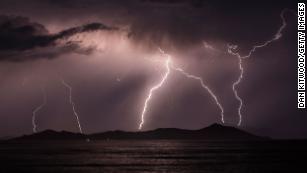Spring cleaning: Science and allergy relief meet at the end of a broom
Posted 4 years ago
0
2K


Decluttering your house can help you live longer 01:28
(CNN)In generations past, the arrival of spring meant not just warming days, chirping birds and frolicking baby animals, but also an energy-intensive project for homemakers: spring cleaning.
After a winter cooped up in a small home heated by wood or coal—the standard heating system until the central HVAC boom of the 1960s—increasingly warmer weather meant a flurry of activity: flinging open the doors and windows, dragging mattresses and rugs out to bake in the sun, and giving the house a top-to-bottom dusting, sweeping and vacuuming.
Although they may not have known it, our forebears had science on their side.
Battling asthma
Take the business of pulling the mattress off the bed and dragging it out into the yard or driveway. Never mind the myth that mattresses double in weight in 10 years because of all the sweat and skin we shed at night. That icky thesis isn't really true, but mattresses do harbor pet dander, mold and other noxious substances, which can be distressing and even harmful to people who suffer from asthma or other conditions. Airing a mattress in the sun — nature's great antiseptic — can do wonders for ridding it of those allergens.

Thunderstorms can trigger asthma attacks that need hospitalization, study says
The incidence of asthma and numerous allergies, reports the US Centers for Disease Control and Prevention has been steadily increasing in just the last couple of decades. It's no surprise that there's an environmental correlation there, for the last couple of decades have also seen an increase in "closed-envelope" buildings that are tightly insulated and feature airtight windows and doors. That closed-in construction is great for energy efficiency, but it gives a fine harbor for one of the main culprits in allergies such as hay fever and assorted respiratory ailments, including asthma.
The dreaded dust mite
That culprit is the tiniest of spiders, the dust mite. Its two-part name, Dermatophagoides farinae, is suggestive of what it does: dust mites live on sloughed-off skin, and humans do shed a lot of it, as much as 1.5 pounds each year. Dust mites, which look like some sort of extraterrestrial monster under a microscope, have a habit of hiding just where that castaway skin is most abundant: mattresses, naturally, but also hard-to-get-to corners of the bedroom and other parts of the house (and of course, our bedclothes).
Those little tufts floating around under the bed that we cutely call "dust bunnies?" They're full of our skin, pet hair, dust, and of course, dust mites enjoying the feast. To compound the unpleasantry, it's not the mites themselves that are the cause of allergies, but their microscopic poop.

The potential mind-altering, life-extending benefits of spring cleaning
Secretions on animal fur (particularly a cat's), and tiny pollen grains that seep into the house when plants are in bloom, create a heady brew about which every allergy sufferer can tell you tales of woe.
The bedroom is probably the scariest room in the house. "I am constantly amazed at the particles I find in bedroom air," wrote organic chemist Jeffrey C. May in collaboration with his wife and air-quality technician Connie L. May in "My House Is Killing Me! A Complete Guide to a Healthier Indoor Environment."
Airing out the mattress is a good start to taming those troublesome particles, as is removing the carpets and giving them a good beating with a fireplace poker or baseball bat, which can shake out carpet beetle dung and other nasty things. Pillows, whether on the bed or couch, are also a paradise for mites, so wash and air-dry them while you're at it.
Getting rid of mold and dust
Other components of dust are also implicated in various allergies. Now we know, thanks to satellite images, that dust floats around the world, picking up pollutants and even radioactive isotopes as it moseys along. That's why it's important to take the time to dust the furniture, too, as well as hard-to-see places like the tops of doors, refrigerators, cabinets and the like.

Spring, the most inspiring of the seasons (this year especially)
The final step is to vacuum every vacuumable inch of the house, including the walls and ceiling. It's no surprise, as Joseph A. Amato writes in his book "Dust: A History of the Small and Invisible," that some of the first vacuum cleaners were made by people who suffered from allergies and asthma: Melville R. Bissell had a fierce allergy to straw, and James Murray Spangler -- who created the company later bought and renamed by William H. Hoover -- was a severely asthmatic janitor.
Most high-end modern vacuums, as the Mays' book explains, come with HEPA filters filter out many kinds of allergens. They aren't cheap, but they do capture all the large particles and 99.97 percent of those suspended in the air as you move along.
Cleaning and clearing the closet
Be sure to get inside your closets while you're vacuuming. While you're in there, you can, if so inclined, steal a page from Marie Kondo and declutter, getting rid of things you no longer need, want or cherish. You might also want to lay in fresh blocks or discs of cedar wood to deter the moths that seem to pop up every spring.
There's no end of good, science-rooted reasons to take the time to give your home a deep cleaning—and since COVID has made homebodies of us, there's no time like now, the beginning of spring, to do so. Your respiratory system will thank you.
Search
Sponsored
Categories
- Industry
- Art
- Causes
- Crafts
- Dance
- Drinks
- Film
- Fitness
- Food
- Games
- Gardening
- Health
- Home
- Literature
- Music
- Networking
- Other
- Party
- Religion
- Shopping
- Sports
- Theater
- Wellness
- News
Read More
Crowd Control Barriers Market Forecast: Meeting the Demands of Safety and Security
Market Overview
The crowd control barrier market is witnessing steady growth,...
Facebook Ads: Maximizing Reach and Engagement
In the ever-evolving landscape of digital marketing, Facebook Ads have emerged as a pivotal tool...
New 5V0-22.21 Test Bootcamp, Reliable 5V0-22.21 Exam Syllabus | 5V0-22.21 Valid Mock Test
What's more, part of that ITPassLeader 5V0-22.21 dumps now are free:...
Biohazard Bags: Essential for Safe and Effective Waste Management
In environments where hazardous biological materials are present, Biohazard Waste Disposal Bags...
IMPORTANCE OF ACCOUNTS RECEIVABLE RECOVERY IN MEDICAL BILLING
Introduction
Medical billing is a process that requires a team of professionals having proficient...


